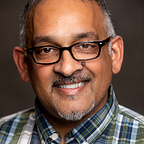Fractals, Families, and Food: The Seeds of Math Education’s Creative Disruption
Up until this past week, each of my 23 Family Math Nights had been in my home Province of Ontario. The farthest one being a small town 3 hours north of Toronto in a K to 8 school of only 65 students. It was a long drive, especially since I drove back home the same night. But, it is precisely schools like these, which usually don’t have access to resources like larger cities, that need support/interest from presenters/speakers who generally bypass such remote communities.
But, that quarter-day of driving was a harbinger of things to come in terms of taking my math show on the road.
Family Math Night #24 and #25 occurred in Austin, Texas. And, that incomprehensible stretching of the radius of these joyful and celebratory math evenings made me reflect as to maybe these 90 minute evenings have a deeper consequence in math education.
Sierpinski Pyramids with LEGO, Tessaracts with Zome Tools, Logic Mazes from out-of-print books, challenging math ideas with Exploding Dots, Number Theory/Egyptian Fractions with Unafix Cubes, and the two best Card Games I know, Albert’s Insomnia and Tiny Polka Dot.
Every station that I have at these Family Math Nights is not only a conscious nod to mathematical ideas/elements generally absent in most classrooms, but an equally deliberate curation of math activities that make the cafeteria/auditorium come alive with the happy, perplexed noise of children — and parents. It sounds like math recess.
Family Math Nights only really work if the parents are equally involved. There has to be that synergy/union of child/parent working through a math activity. Not so much for the solution — often the maze activities go unsolved — but for the shared experience of nutting one’s way through a complexity(often unexpected) and smiling/laughing all the way.
Or as James Tanton likes to say, funstration!
Also at these evenings, the parent council/teachers have light refreshments, which as I reflect, are also a critical element in adding to the experience of a Family Math Night. Eating a cookie/cupcake while nestled into deep problem-solving activity with friends and family has a tsunami-effect of multiplying the happiness of the mathematical experiences. As well, there is change in time and space of where math is intersected. It is just no longer confined to the working hours of 9 to 4 in classrooms. It now occurs in larger venues in the evening.
But, the key thing, for me anyways, is to showcase approaches to mathematics that unleash it from the structure/stress sometimes found in classrooms — tests, worksheets, computations/etc.
The activity that symbolizes the spirit of my Family Math Night is the Sierpinski Pyramid that is built with 1024 piece of square LEGO. The seed pyramid is built with two pieces at the back, one at the front, and a fourth one on top. Over the next 90 minutes, kids and their parents will work feverishly and meticulously in the most communal and convivial ways to put 256 of these mini-pyramids together to build the commanding level 5 Sierpinski.
Exponents, self-similarity, and zero-volume(eventually). Now do that with a cookie in your mouth and with the warmth of friends and family around…
Mathematics is, at bottom, about play, freedom, and wild exploration. It’s not a new narrative. It’s about a few thousand year old. Thankfully, through the connected efforts of many kindred educational spirits, the original spirit for learning mathematics is getting closer and closer to the educational institutions that have ironically kept it at bay.
The evolution of needed verbs in math education has gone from Engagement to Innovation.
We are now at the doorsteps of an idea that will forever transform how and why we learn mathematics. We are in the embryonic stages of Creative Disruption. And nowhere is that more emotionally palpable for me are the wonderful evenings I spend with parents, kids, teachers, and administrators simply playing with math.
Playing more for the reflective and shared journey of problem solving than the terminal answers they house.
The school cafeteria at dusk seems like an odd place for mathematical revolution. But, if its the place where we ALL meet, then let us trumpet the beginning of new ideas with mathematical conundrums — and cookies.
Don’t forget the cookies:)
